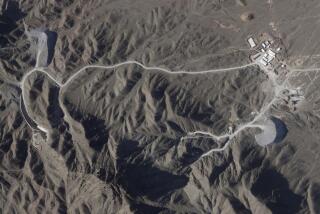Other Nations’ Research Is Well Off
While the United States stands ready to shut down its deepest research well far short of its modest goal, other countries--particularly Japan, West Germany and the Soviet Union--are moving aggressively ahead with deep-drilling programs for scientific research, scientists say.
The U.S. well is on Cajon Pass just two miles from the San Andreas Fault, and it was supposed to reach 16,000 feet, where it would probe the innards of the giant fault.
“It looks like we’re going to run out of money about March 9,” said Stanford University geophysicist Mark Zoback, the project’s chief scientist.
Zoback is chairman of the coordinating committee for continental drilling of the International Lithosphere Program. He has just returned from the Soviet Union, where 11 deep-research wells are being drilled.
The Soviets have drilled more than 7 miles into the Earth on the Kola Peninsula, the world’s deepest research well, and “they have developed a computerized drilling system,” Zoback said, thus streamlining deep-drilling procedures.
While the Soviet drilling program is aimed at learning more about the geological forces that created and trapped resources in that country, both Japan and West Germany are in the field to develop export technology, Zoback said.
The Germans hope to drill the deepest well of all, probing the Earth to a depth of nearly 9 miles.
“The Germans have built a laboratory facility at the site that is comparable to the best university facilities today,” Zoback said. “It’s just mind boggling.”
The most prominent failure in research drilling belongs to Sweden.
The Swedes have been forced to suspend drilling on an ambitious project that they had hoped would give them their first local supply of natural gas. American astronomer Thomas Gold had persuaded the Swedish government that hydrocarbons are formed deep within the Earth, not by biological decay.
Gold believes that hydrocarbons move to the surface through weaknesses in the Earth’s crust, and he argued that an impact crater in Sweden left by a giant meteorite would be a perfect place to test his theory. The impact would have fractured the ground to great depths, Gold argued, thus opening the way for the gas to move toward the surface.
But no gas has been found, even though the well passed through a couple of promising geological structures. And major drilling difficulties have been encountered. Scientists familiar with the project said the drill strayed off course by as much as 45 degrees.
More to Read
Sign up for Essential California
The most important California stories and recommendations in your inbox every morning.
You may occasionally receive promotional content from the Los Angeles Times.








